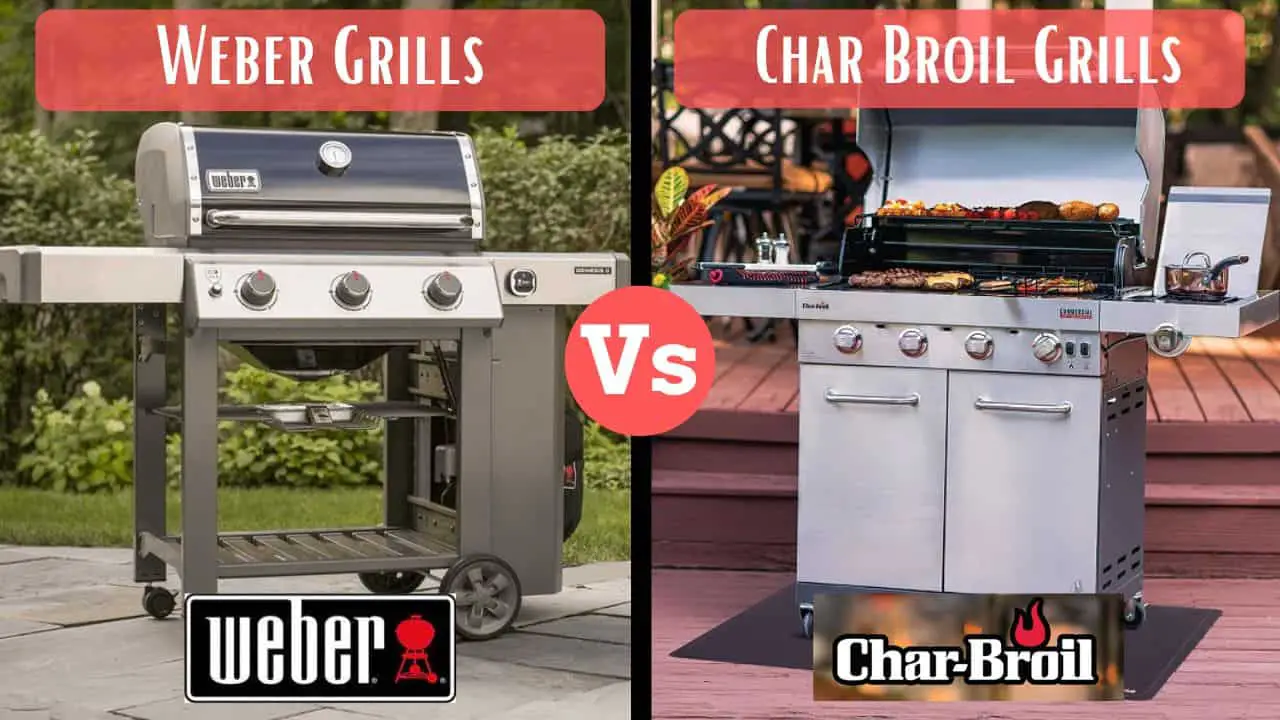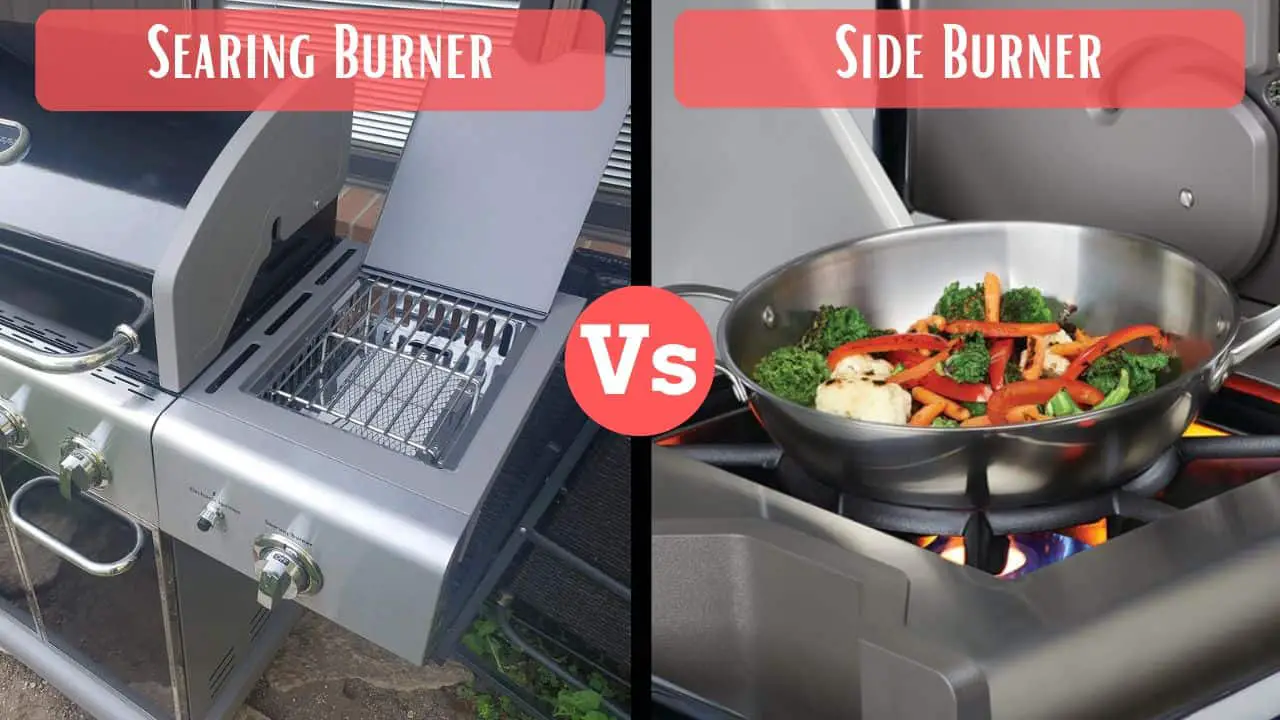I’ve been using gas grills for quite some time now, but was in the market for a grill that could produce searing temperatures—an infrared grill.
You’ve probably heard of infrared grills, and just like me are wondering how they stack up to gas grills?
Well, without further ado, here’s a detailed analysis of infrared grills vs. gas grills to help you choose the right appliances for your needs.

Table of Contents
- 1 Infrared Grill vs. Gas Grill – The Main Aspects
- 1.1 1. Heating Method
- 1.2 2. Fuel Used
- 1.3 3. Temperature Ranges
- 1.4 4. Cooking Time
- 1.5 5. Grilling Quality & Taste
- 1.6 6. Fuel Efficiency
- 1.7 7. Sizes
- 1.8 8. Ease of Usage
- 1.9 9. Type of Cooking Possible
- 1.10 10. Flare-Ups
- 1.11 11. Portability
- 1.12 12. Safety Features
- 1.13 13. Price
- 1.14 14. Ease of Cleaning and Maintenance
- 2 Advantages of Infrared Grills
- 3 Advantages of Gas Grills
- 4 Disadvantages of Infrared Grills
- 5 Disadvantages of Gas Grills
- 6 Overall Are Infrared Grills Better than Gas Grills?
- 7 Which Infrared Grill to Buy?
- 8 Which Gas Grill to Buy?
Infrared Grill vs. Gas Grill – The Main Aspects
1. Heating Method
Unlike gas grills, infrared grills use direct heat to cook your food. This type of heating greatly reduces your cooking time, so you get grilling faster.
Gas grills use flame heating to cook your food. They take longer to cook your food, because they heat the air, which then heats your food. Infrared burners contrarily heat your food directly, so your food cooks faster.
With regards to the heating method, there are three different types of infrared burners, and two common types of burners.
Ceramic infrared burners – just as the name would suggest, ceramic infrared burners use ceramic plates tucked away neatly within a stainless-steel housing.
Ceramic infrared burners produce a higher cooking temperature up to 1200 degrees and heat up quickly within three to five minutes.
TEC’s radiant glass system – TEC bills itself as the founder of infrared grilling technology, and the burner system the company invented features a durable steel burner topped with a radiant glass panel, and cooking grip on top.
One of the ley features of this infrared heating method is that it can cook at temperatures as low as 200 degrees F to grill super delicate foods such as vegetables.
Heat emitter system – this type of infrared burner heating method features a stainless-steel tube burner, complete with a metal heat emitter panel that sits directly over the emitter panel.
Cast burners (gas grills) – this type of gas grill burners can be made from stainless steel, brass or iron, and are available in a wide range of shapes cast ceramic, and cast-iron pipe burners.
Stainless steel burners – most top-of-the-line grills come with stainless steel U-shaped pipe burners.
Winner:
Even though infrared grills heat up food faster, this may not always be what you want.
Direct heat cooking is good for some foods such as steaks, and other cuts of meat, but indirect heat produce by the gas grill heating method works well for all types of food items.
2. Fuel Used
Both infrared grills and gas grills can use one of two fuel options—propane or natural gas.
If you buy a propane infrared or gas grill, you will need to buy a conversion kit to connect it with your natural gas line, so it’s best to decide which fuel option is right for you from the start.
One of the biggest benefits of connecting an infrared or gas grill with a natural gas line is that you won’t have to deal with replenishing the gas in propane tanks, and you will also save yourself the effort of hauling around empty and full propane tanks around town.
Winner:
Infrared propane grills and gas grills
3. Temperature Ranges
The temperature range of an infrared grill depends on the type of burner installed, but some high-end models can produce more than 1800-degrees of high heat.
Charcoal grills aren’t that far behind, and some top models can deliver 1200-degree temperatures to the cooking surface.
Winner:
If you cooking foods that require high heat often, then an infrared grill is a great option. But if you cook delicate foods often, and meats occasionally, a gas grill is the winning option for you.
4. Cooking Time
The cooking times of infrared grills and gas grills vary depending on the food you’re cooking. Infrared grills can cook a whole chicken in 45 to 60 minutes, a well-cooked beef roast in 25 minutes per lbs, pork roast in 25 minutes, and a turkey in roughly two hours.
Adding to this, if you’re cooking for a large crowd often, and don’t want to keep your guests waiting for grilled delights, grilling faster with an infrared grill is perhaps a good choice.
Preheat times are also much quicker with infrared grills, which means that you can get started with grilling in three to five minutes.
Cook times for the above-mentioned food items are around 15 minutes to 20 minutes with gas grills.
Winner:
If you like slow-cooked food, a gas grill is right for you, and an infrared grill if you want to cook food quickly.
5. Grilling Quality & Taste
The grill quality and taste of both infrared grills and gas grills mostly depend on the marination you use, and how well you grill.
Of course, since infrared grills provide a higher heat temperature, you will be able to create sear marks faster, but takes a bit longer with gas grills.
The taste produced also dates back to the heating method of both types of grills. Gas grills use the convection method to break down the moisture barrier in meats, causing the meats to dry out when grilling.
Infrared grills however directly heat the meat through their respective heating system, hence trapping the fluids, resulting in juicier cooked foods.
But if you’re just getting your feet wet with grilling, it’s easy to overcook and char food on an infrared grill, for which a gas grill is a better option for you.
Winner:
Infrared grills – Seasoned grillers
Gas grills – Novice grillers
6. Fuel Efficiency
Infrared grills provide better fuel efficiency than gas grills, because the flame they produce isn’t exposed to the air.
And I have already mentioned earlier, gas grills work contrarily by heating the air first, which then heats your food.
When you open the lid of your infrared grill, the heat temperature drops, but not as much as a gas grill.
Since the heat in a gas grill escapes quickly due to the air, you have to reheat the grill to reach the desired cooking temperature.
Owing to this heat loss, gas grills use more fuel than infrared grills. Adding to this, the high temperature of an infrared burner also plays a pivotal role in fuel efficiency, because it takes less time to preheat the grill, therefore consumed less fuel.
Winner:
Infrared Grills take the win here.
7. Sizes
Infrared and gas grills are available across a spectrum of sizes, starting from compact models to models that have the capacity to feed your entire neighborhood.
There are also several infrared models that can be used for indoor grilling, but gas grills whether big or small will have to be outdoors.
8. Ease of Usage
Infrared grills and gas grills both are relatively simple to use. However, there may be a bit of a learning curve with infrared grills, especially if you’re a beginner, because it’s easy to overcook and burn food the first few times, owing to the high temperatures.
Winner:
Due to steeper learning curve on using infrared grills and the risk to overcook your food the win for ease of usage goes to Gas grills by a small margin specially for a beginner griller.
9. Type of Cooking Possible
Infrared grills are a great choice for cooking tough meats such as steaks and burgers, and can cool fish and vegetables too, as long as you have good control over the temperatures.
You can literally cook any type of food on a gas grill, but the food will just cook slower than on an infrared grill.
Winner:
Infrared grills – Most types of meat
Gas grills – All types of food
10. Flare-Ups
Flare-ups are those sudden outbursts of flames when grilling, and the common myth is that infrared grills are more prone to flare-ups, due to their high heat capabilities.
However, this isn’t true, because flare-ups are caused when the liquids from the food drip onto the flame, and when it’s windy outside.
But, remember, the flames of an infrared grill are located above the ceramic plate, so the drippings don’t drip directly onto the flames.
Plus, the grates of an infrared grill have a concave shape to accumulate the liquids and juices that drip from the food when grilling. Flare-ups are very common with gas grills, the flame is exposed to the air.
Winner:
Infrared grills
11. Portability
Infrared grills and gas grills can be ordered in a wide range of sizes, big and small! The portable models generally come with a handle to carry them around, and large models are fitted with wheels to cart them across spaces.
Both types of grills are a bit heavier, given the accompanying gas tank (unless natural gas), but most people don’t move them around once set in a permanent location.
Winner:
Both Infrared and gas grills are tied here since each has variants that are portable and can be moved around easily.
12. Safety Features
Infrared grills are much safer to use than gas grills, because there are no flare-ups to deal with.
There are however certain things you can do to prevent flare-ups on gas grills such as trimming the fat, keeping the lid open, avoiding wind, moving your food, burning the grease away, and most importantly—cleaning your grill.
Apart from that, both infrared and gas grills do not come with any specific safety features, but you can employ a few practices for safe grilling such as grilling outside, checking your grill for leaks, cleaning your grill after each use, and wearing appropriate clothing.
Winner:
Just by a margin here is the Infrared grill.
13. Price
Infrared grills are the new kids on the block, therefore will cost more than gas grills. There are also top gas grill models that cost a whole lot more than infrared grills. The good news is that there are budget-friendly models in the infrared grill and gas grill segment.
Winner:
Gas Grills have a relatively cheaper starting range.
14. Ease of Cleaning and Maintenance
The basics of cleaning an infrared grill are the same as a gas grill, or any type of grill. But, you have to take extra caution when cleaning the heating element, and infrared surface.
Adding to this, infrared and gas grills that feature a side burner are harder to clean than those that don’t.
Advantages of Infrared Grills
Infrared grills offer myriad benefits for grillers, most notably:
1. Preheat quickly
Infrared grills preheat in two to five minutes, so you don’t have to wait around the grill when all you want to do is eat, unwind, and prepare for the next day.
The preheat time is comparatively the same as microwave cooking, except that your food tastes way better!
2. Even heat distribution
Achieving even heat distribution with gas grills takes a fair bit of skill, but not with infrared grills. Infrared grills use radiant energy to heat the food directly, and this is heat is not concentrated to just one part of the cooking surface, but is spread evenly across the cooking area.
3. Cooks food fast
Infrared grills render consistent heat vita their integrated infrared element. They heat the food directly, hence cook the food quickly. They not only achieve a higher temperature in a fraction of the time, but cook food faster as well.
4. Minimizes the chances of flare-ups
The heat generated by infrared grills is extremely intense, so much so that it literally vaporizes the grease or marinade, converting it into flavorful smoke in the process. This offers twofold benefits—enhances the food’s flavor, and greatly reduces the chances of flare-ups.
5. Easy to clean
Infrared grills are easy to clean by simply turning up the grill on high heat, and leave it there for a couple of minutes to vaporize any grease, and turn any food residue into fine ash.
Advantages of Gas Grills
Just like infrared grills, gas grills offer a fair share of advantages such as:
1. Instant ignition
You can start a gas grill with the push of a button or turn a knob to fire up the grill.
2. Economical and efficient
Gas grills are cheaper to buy than infrared grills, and generally offer a long service life. There are also several pocket-friendly models available, making it easy to buy the right one for your budget.
3. Grilling on gas grill is healthier
Grilling on a gas grill is considered healthier than other types of cooking methods, because the fat and other unhealthy grease drips away from the food in a few minutes after it comes in contact with the grates.
4. Easy to use
The controls of a gas grill as similar to your indoor stove top, where the flames can be easily controlled by the knobs on the appliance.
Controlling the temperature is an important part of grilling, as well as the ability to adjust the temperature to prevent the food from burning.
5. Gas grills emit less smoke
Gas grills do not emit much unhealthy smoke if you use the grill properly. To reduce the smoke produced by the gas grill, manufacturers recommend heating your brand-new grill for a few minutes to eliminate the smoke before first use.
Disadvantages of Infrared Grills
Infrared grills aren’t perfect, and here are a few disadvantages that you may or may not face.
1. Heat up too quickly
While this is a good thing for most grillers, the risk of burning food is high, especially if you don’t know how to control the heat.
Many people who enjoy slow cooking may also find infrared grills to be a bit overwhelming to use.
2. Less versatility with most infrared grills
Most infrared grills don’t offer a wide temperature range, and also don’t provide the necessary controls to adjust the speed at which food gets cooked.
3. Prone to damage
The plates of infrared grills may look sturdy, but are prone to chipping and cracking. Further, I’ve read some infrared grill reviews claiming that these grills and more prone to mechanical failure as well.
4. Doesn’t offer wood or charcoal flavoring
If you can’t resist the wood or charcoal flavors when you BBQ, you’ll be a tad bit disappointed with an infrared grill.
5. Infrared grills are expensive
Infrared grills are notoriously expensive compared to other types of grills. However, there are several cheap infrared grills available, but models in this range don’t provide a true infrared grilling experience.
Disadvantages of Gas Grills
Gas grills also have a few disadvantages that may or may not apply to you.
1. Fuel Refilling
Unless you’re using natural gas, you will have to buy and refill propane tanks at an added cost. Depending on how much and/or how often you grill, these costs can quickly add up.
To give you an idea, the cost to refill a propane tank is roughly $20 in most states.
2. Hard to get Smoky flavor
Even though this is subjective, it’s not very easy to smoke with a gas grill. There are however a few things you can do to achieve that smoky flavor, but you will have to pay extra for these things.
3. Durability
Gas grills are extremely durable with proper care, but certain parts do need to be replaced periodically such as gas lines and burners. Additionally, there are also more parts to clean in a gas grill.
Overall Are Infrared Grills Better than Gas Grills?
The question of whether infrared grills are better than gas grills is a bit tricky, because it depends on your needs.
If you like to cook your food fast, and with little or no flare-ups, infrared grills are a great option. Furthermore, if you don’t want to spend a long time cleaning your grill, then choose an infrared grill.
But on the downside, you will need a fair bit of expertise to operate an infrared grill, due to the high heat they generate.
And needless to say, infrared grills can be big-ticket purchases, and some of their parts are prone to damage, so choose a model that comes with a long manufacturer warranty.
Gas grills have been around for decades, and are still a go-to choice for seasoned grillers. They allow you to cook food slowly, so you can cook all types of food including veggies without burning or charring them.
Gas grills are also easy to use with their push-start ignition systems, and control knobs, making them a great choice for novice grillers.
I use a gas grill for veggies and fish, and an infrared grill for meats such as sausages, steaks, or when grilling for a large crowd.
Which Infrared Grill to Buy?
Char-Broil 463655621 Performance TRU-Infrared Propane Gas Grill
For an infrared grill that comes with key features, and provides an unmatched infrared grilling experience, the Char-Broil Performance TRU-infrared grill is hard to beat.
It offers 310 square inches of primary cooking area, and also comes with a separate 95 square inch warming rack that’s ideal for heating up sauces and buns.
It features the latest TRU-infrared technology, which prevents flare-ups, delivers even heat, and cooks up to 50 percent juicier food.
The Char-Broil infrared grill features an appealing metallic gray finish, and comes with durable porcelain-coated cooking grates that are easy to clean, and are rust-resistant.
Adding to its rich set of features is its onsite electronic ignition system, which allows you to get grilling in no time.
The Char-Broil Performance infrared grill comes with foldable side shelves, and a large storage compartment at the bottom to store your grilling essentials.
Adding to this, the Char-Broil infrared grill is fitted with a lid-mounted temperature gauge, four heavy-duty wheels, and is easy to assemble.
Pros:
- 310 square inches of primary cooking space
- 95 square inches side burner
- Rich metallic gray finish
- Electronic ignition system
- Latest TRU-infrared technology
Cons:
- Limited to one color option
Which Gas Grill to Buy?
Monument Propane Gas Grill
The Monument gas grill not only looks good, but offers some serious power under its hood. It offers a large 473 square inch primary cooking space, and a separate 147 square inch warming rack.
It is equipped with two 304 grade stainless steel burners that collectively generate an impressive 24,000 BTU heat power.
The Monument Gas grill comes with porcelain coated, cast iron cooking grates that provide even heat across the cooking surface.
It features a sturdy construction with its 430-grade stainless steel lid, black powder coated side shelves, side panel and base panel.
The Monument gas grill features an electronic ignition for easy starting, and come with wheels to easily to move it around.
Pros:
- 473 square inch primary cooking space
- 147 square inch warming rack
- Two 304 grade stainless steel burners
- Porcelain coated, cast iron cooking grates
- Electronic ignition
Cons:
- Doesn’t come with storage box





